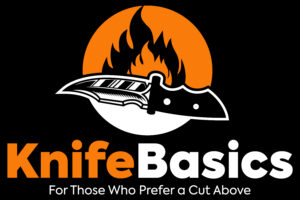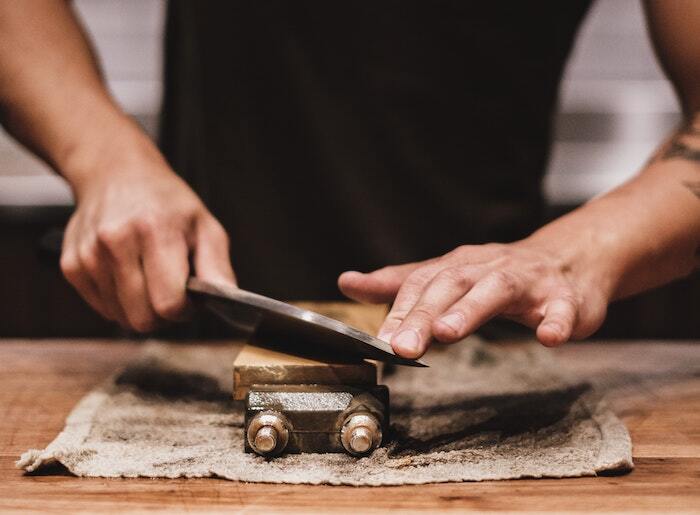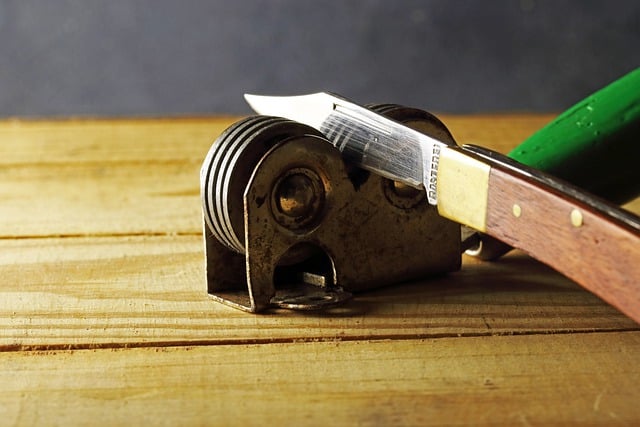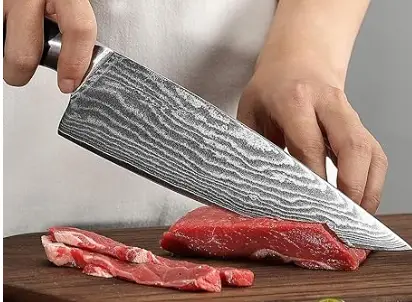You must have heard about sharpening angles if you are learning knife sharpening skills. Selecting the right sharpening angle is an important step in knife sharpening because it determines the blade’s sharpness and durability. So, what is the best angle to sharpen a knife?
The best angle to sharpen a knife depends on how you intend to use the knife, the thickness of the blade, the steel used to make the blade, the sharpening tools used, and your preference. Knives have no standard sharpening angle, but most kitchen knives are sharpened at a 15-20 degrees angle.
This article will discuss factors that determine the best sharpening angle, different sharpening angles, and the importance of choosing the right angle. Let’s get into it!
Factors That Determine the Right Sharpening Angle
Determining the best sharpening angle is easy as long as you know other knife sharpening basics. Here are factors that determine the best sharpening angle for your knives.
Use of the Knife
Smaller sharpening angles produces very sharp blades ideal for precise cutting and chopping. On the other hand, wider angles create durable blade edges suitable for demanding cutting jobs like slicing bones or cutting coarse vegetables.
Steel Hardness
The Rockwell hardness of the steel used to make your knife blade determines its durability. Different types of steel offer varied strength, and this impacts the sharpening edge.
Knife blades made from hard steel should be sharpened at smaller angles because they yield a lot of strength. Soft steel, on the other hand, should be sharped at steeper angles which helps them withstand the stress without deforming.
Blade Thickness
Knives with thin blades get a sharp edge faster when sharpened at lower angles. On the other hand, thick blades should be sharpened at wider angles because they have a lot of material on the edge, and it will take you more time and energy to get a sharp edge.
Knife User’s Preference
Are you looking for sharpness or durability? Your choice between the two determines the angle you will use. A lower sharpening angle will give a very sharp edge, while wider angles give you a durable blade.
- CONVERT YOUR KNIVES: Ideal for converting traditional 20-degree factory edges of household knives into high performance Trizor XV 15-degree edges
- DIAMONDS: Advanced stropping stage and 100 percent diamond abrasives for sharpening straight edge and serrated blades
- EASY TO USE: Advanced, patented flexible spring guides for automatic adjustment and accurate control of the sharpening angle and feature simple on/off switch
- THREE STAGES: 3-Stage EdgeSelect sharpening system for optimum versatility in providing the perfect edge for each cutting task. Stages 1 and 2 are plated with 100-percent diamond abrasives to sharpen and hone the edge and stage 3 uses a patented flexible abrasive system to polish and help prolong the life of serrated knives
- RAZOR SHARP: The 15 Trizor XV combines the strength and durability of the Trizor edge with the flawless, ultra-sharp 15-degree XV technology. Time Required to sharpen is approximately 1 minute for first time sharpening and resharpening is approximately 10 seconds
- 3-Step Knife Sharpener: With our incredible 3-slot system, we’re revolutionizing the art of knife sharpening! The 1st diamond sharpening rod repairs and straightens damaged blades before the 2nd slot sharpens to restore its V-shape. Finally, the 3rd slot fine tunes for a clean polish.
- Easy to Use: Whether you’re right or left-handed, the ergonomic handle allows you to restore your cooking knives in a matter of seconds! Simply place the blade in each of the slots and gently pull the knife through a few times for fast, effective sharpening.
- Cut-Resistant Glove Included: At Kitchellence, we put the safety of our customers above all else. Designed with a non-slip base, our kitchen knife sharpener offers comfortable control while you work. We’re even including a cut-resistant glove for added safety!
- Premium Quality: With our professional knife sharpener kit, you don’t have to be a chef to cook like one! Crafted from solid ABS plastic, it’s strong, durable and designed to last a lifetime. Made with high quality materials, knives will look and work like new.
- 【10x Sharpness】After four years of testing and optimization, this sharpener increases knife sharpness by up to 10 times compared to ordinary sharpeners. The resulting blade provides precise and clean cuts, significantly improving cooking efficiency whether slicing meat or chopping vegetables. It's the ideal choice for professional chefs and cooking enthusiasts.
- 【Ultra-Fast and Convenient, No Manual Effort Required】Features an electric automatic sharpening design. Simply plug it in, and sharpening your knife in seconds. Say goodbye to the tediousness and effort of traditional manual sharpening. No professional skills are required; even beginners can easily operate it, saving daily cooking preparation time.
- 【Versatile and Versatile】Highly adaptable, it can sharpen not only various kitchen knives but also scissors, pocket knives, curved knives, and even blender blades. It provides a one-stop solution for sharpening various blades at home and outdoors, eliminating the need to purchase additional specialized sharpening equipment.
- 【Durable and Long-Lasting Tungsten Steel Material】The body is constructed from high-strength materials, with the core sharpening components made of wear-resistant tungsten steel. This robust material is resistant to wear and tear, maintaining a stable sharpening effect over a long period. Its lifespan far exceeds that of ordinary sharpeners, offering excellent value for money.
- 【Safe and Worry-Free, Reducing Usage Risks】Compared to the safety hazards of slipping when cutting with dull knives, knives sharpened with this material can achieve precise cuts, effectively reducing the risk of accidents during cooking. The product's ergonomic design ensures stable and controllable operation, making it safer to use.
Sharpening Angles for Knives
Under 10 Degrees
Sharpening angles of less than 10 degrees result in delicate edges that are easily damaged. Such edges are suitable for blades used to cut soft material because there is less risk of abuse that might lead to breakage and other forms of damage.
Such low angles of 7 to 8 degrees are easily achieved using fine sharpening tools with at least 1000 grit, like water stones. This angle is very low for knives. It is suitable for straight razors used to cut soft materials like hair.
10-15 Degrees
Sharpening angles falling under this category produce very fine and delicate edges, but it is low for most knives. These angles should not be used to sharpen blades made from very hard steel because the blades are very brittle and highly susceptible to damage.
Knives sharpened at this angle should only be used for slicing meat or cutting very soft foods but never for chopping needs. They should only be sharpened using very fine abrasives like water stones.
15-17 Degrees
Most Japanese and new cutlery are sharpened at 15-17 degrees. It is the lowest angle recommended for most blades, and they produce good cutting power. The edges produced are less durable than wider sharpening angles, but the sharpness achieved pays off.
Therefore, use angles between 15 and 17 if only you are looking for sharpness. Different sharpeners for this angle include guided systems, sharpening stones, or powered sharpeners.
17-22 Degrees
Most kitchen and outdoor knives fall under the category of 17-22 sharpening degrees. Japanese knife manufacturers recommend 17 degrees for their knives, while western knife manufacturers use 20 degrees.
Knives sharpened in this category offer both durability and sharpness, and it can be achieved using guided systems, sharpening stones, or powered sharpeners.
22-30 Degrees
Sharpening angles between 22 and 30 degrees produce durable edges. This range is ideal for outdoor or kitchen knives used for tough applications. The edges do not give precise cuts, but they will withstand impact and pressure without breaking or chipping.
Most sharpeners can sharpen these angles, including guided systems, sharpening stones, and powered sharpeners.
Over 30 degrees
Knives sharpened past 30 degrees are durable but at the sacrifice of their cutting ability. Cutlers like axes, machetes, and cleavers are sharpened at this range, allowing them to withstand the cutting abuse they are subjected to.
Knife Sharpening Angle Chart
The chart below will help you determine the best sharpening angle for knives and tools
| Knife/Tool | Recommended Sharpening Angle |
|---|---|
| Cleaver Machete Axe | Over 30 degrees Offers durability |
| Hunting Knives Pocket Knives Sport Knives | 22-30 degrees Offers more durable edges |
| Chef’s Knives Kitchen Knives Smaller Knives Boning Knives Carving Knives | 17-22 degrees Offers both sharpness and durability |
| Fillet Knives Paring Knives Sushi Knives Most Japanese Cutlery | 12-17 degrees Offers fine and delicate edges |
| Straight Razors Razor Blades X-Acto Knives | 7-12 degrees Very delicate edge |
What Is The Best Sharpening Angle For Beginners?
- CONVERT YOUR KNIVES: Ideal for converting traditional 20-degree factory edges of household knives into high performance Trizor XV 15-degree edges
- DIAMONDS: Advanced stropping stage and 100 percent diamond abrasives for sharpening straight edge and serrated blades
- EASY TO USE: Advanced, patented flexible spring guides for automatic adjustment and accurate control of the sharpening angle and feature simple on/off switch
- THREE STAGES: 3-Stage EdgeSelect sharpening system for optimum versatility in providing the perfect edge for each cutting task. Stages 1 and 2 are plated with 100-percent diamond abrasives to sharpen and hone the edge and stage 3 uses a patented flexible abrasive system to polish and help prolong the life of serrated knives
- RAZOR SHARP: The 15 Trizor XV combines the strength and durability of the Trizor edge with the flawless, ultra-sharp 15-degree XV technology. Time Required to sharpen is approximately 1 minute for first time sharpening and resharpening is approximately 10 seconds
- 3-Step Knife Sharpener: With our incredible 3-slot system, we’re revolutionizing the art of knife sharpening! The 1st diamond sharpening rod repairs and straightens damaged blades before the 2nd slot sharpens to restore its V-shape. Finally, the 3rd slot fine tunes for a clean polish.
- Easy to Use: Whether you’re right or left-handed, the ergonomic handle allows you to restore your cooking knives in a matter of seconds! Simply place the blade in each of the slots and gently pull the knife through a few times for fast, effective sharpening.
- Cut-Resistant Glove Included: At Kitchellence, we put the safety of our customers above all else. Designed with a non-slip base, our kitchen knife sharpener offers comfortable control while you work. We’re even including a cut-resistant glove for added safety!
- Premium Quality: With our professional knife sharpener kit, you don’t have to be a chef to cook like one! Crafted from solid ABS plastic, it’s strong, durable and designed to last a lifetime. Made with high quality materials, knives will look and work like new.
- 【10x Sharpness】After four years of testing and optimization, this sharpener increases knife sharpness by up to 10 times compared to ordinary sharpeners. The resulting blade provides precise and clean cuts, significantly improving cooking efficiency whether slicing meat or chopping vegetables. It's the ideal choice for professional chefs and cooking enthusiasts.
- 【Ultra-Fast and Convenient, No Manual Effort Required】Features an electric automatic sharpening design. Simply plug it in, and sharpening your knife in seconds. Say goodbye to the tediousness and effort of traditional manual sharpening. No professional skills are required; even beginners can easily operate it, saving daily cooking preparation time.
- 【Versatile and Versatile】Highly adaptable, it can sharpen not only various kitchen knives but also scissors, pocket knives, curved knives, and even blender blades. It provides a one-stop solution for sharpening various blades at home and outdoors, eliminating the need to purchase additional specialized sharpening equipment.
- 【Durable and Long-Lasting Tungsten Steel Material】The body is constructed from high-strength materials, with the core sharpening components made of wear-resistant tungsten steel. This robust material is resistant to wear and tear, maintaining a stable sharpening effect over a long period. Its lifespan far exceeds that of ordinary sharpeners, offering excellent value for money.
- 【Safe and Worry-Free, Reducing Usage Risks】Compared to the safety hazards of slipping when cutting with dull knives, knives sharpened with this material can achieve precise cuts, effectively reducing the risk of accidents during cooking. The product's ergonomic design ensures stable and controllable operation, making it safer to use.
How Do You Know if you’ve Got The Right Angle?
Importance of Choosing the Right Sharpening Angle
Choosing the right sharpening angle is important because it determines the sharpness and durability of the blade. These properties determine the purpose of the knife. As a rule of thumb, smaller angles offer fine and sharp edges suitable for soft cutting needs. On the other hand, wider sharpening angles offer durable edges that can withstand abuse from demanding applications.
- 【Exclusive Built-in Sharpener】Kitchen knife set with sharpener is amazing. The self-sharpening block keeps the knives razor sharp effectively. It saves you from having to honing blades on a sharpening steel.
- 【Premium Knife Set】Made of forged, high-carbon one-piece German stainless steel, this cutlery knife block set is tarnish-resistant and rust-resistant. The knife set is well-made with a nice appearance. They are sharp, durable, and have good weight and balance, providing effortless cutting. Perfect for both professional chefs and beginner.
- 【Easy to Clean Up】: The kitchen knife set with block is easy and fast to clean. Hand-wash for best results. The blades are stainless and rust-free after going through washing.
- 【Easy to Store】: All knives are stored safely in the knife block with built-in sharpener for space efficient storage. The block is easy to clean and maintain. It is durable and doesn't take up too much space on the counter. Made of natural rubberwood,this wooden kitchen knife block is strong and sturdy to hold heavy knife sets and is finished with a beautiful veneer that’s naturally resistant to grime and easy to wipe clean
- 【Best Sharp Knife Set】Optimized weight and good balance make this kitchen knife set fit nicely in the palm of hand. Exclusive taper grind edge technology provides optimum sharpness for precise cutting and is easy to re-sharpen. The knives are sturdy and can handle heavy chopping. The knives set stays sharp even after extended use.
- Multipurpose Knife Set: This kitchen knives set includes 8" Chef Knife, 8" Slicing Knife, 7" Santoku Knife, 8" Serrated Bread Knife, 5" Utility Knife, 3.5" Paring Knife, Kitchen Shears and 6 pcs Blade Guards
- Anti-rust coating: The healthy anti-rust coating protects the knife from oxidation and dishwasher safe, while the non-stick coating ensures the blades stay clean all day long
- Easy to carry: Each knife comes with a blade guard for safe, compact storage in your kitchen cupboard. These knives are also easy to carry when camping or storing in your RV
- Perfect Holiday Gift: Ideal for kitchen enthusiasts or new cooks, this knife set meets all cooking needs. It makes an excellent holiday gift for family, friends, lover and colleague
- Lifetime Warranty: Every knife set is backed by rigorous quality inspection, we provide a lifetime warranty for every customer, ensuring superior customer service and peace of mind with every purchase
- ULTRA-SHARP BLADES: Superior professional-level sharpness that ensures precision cutting.
- THE LAST KNIFE YOU’LL EVER NEED TO BUY: German Engineered Knife Informed by over 100 Years of Mastery. HENCKELS knives are built to last.
- EFFORTLESS CUTTING: Enjoy easy cutting with minimal effort with this lightweight, easy-to-use knife.
- SET INCLUDES: 3-inch paring knife, 5-inch serrated utility knife, 7-inch santoku knife hollow edge, 8-inch chef's knife, 8-inch bread knife, 4.5-inch steak knife set of 6, professional honing steel, kitchen shears, and hardwood knife block
- QUICK CLEAN UP: No-fuss cleanup, in the dishwasher or by hand. Stain and rust-free blades.









